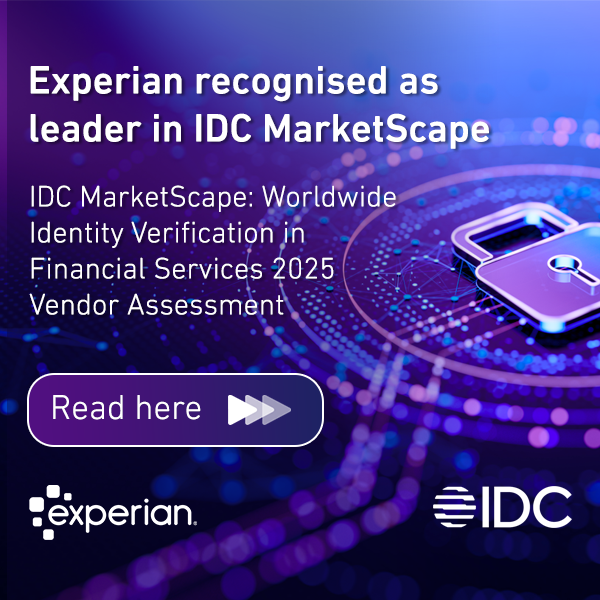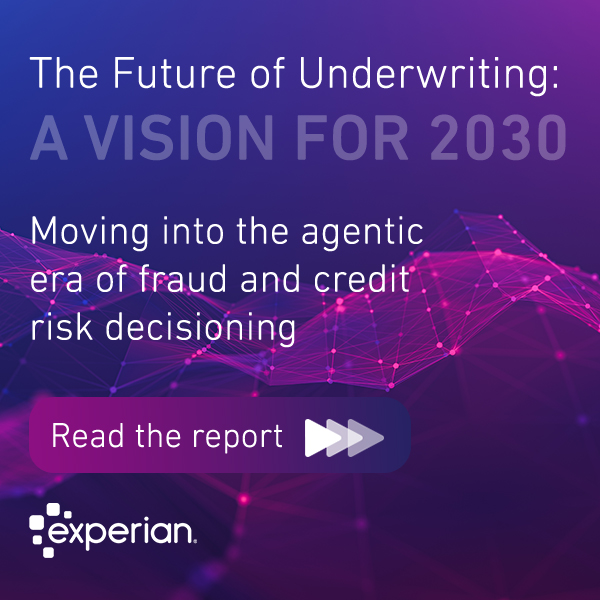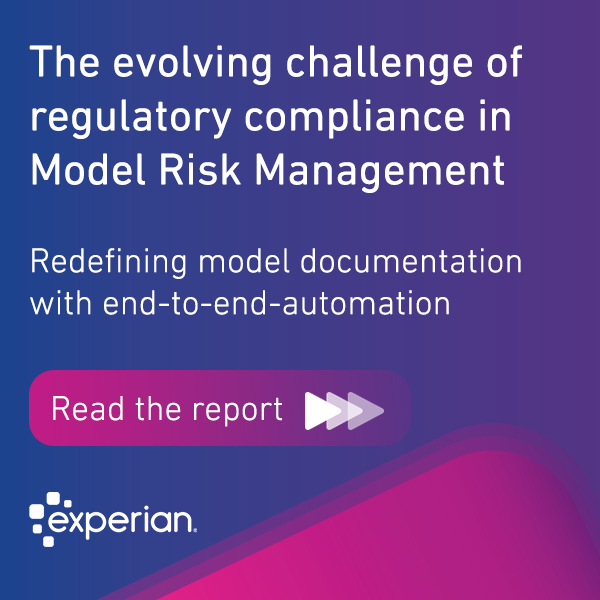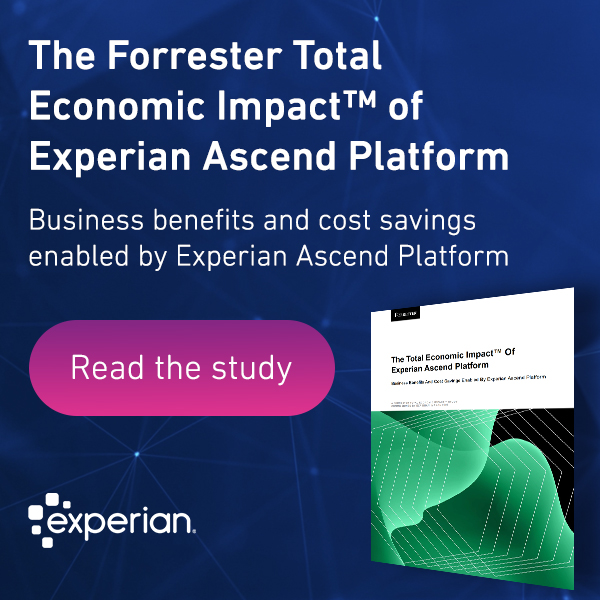Search Results for: DATA AI

By leveraging insights from leading industry analysts, Experian's expertise, extensive market studies, and market sentiment, we identified four key themes shaping the financial services sector this year. Read now Four themes impacting financial services this year: 1. Fraud evolution driven by AI Tracking synthetic identities is a big challenge for FIs in 2025, exacerbated by fraudsters' use of Gen AI tools to scale activities. Investment in AI is a growing priority as banks seek to strengthen identity verification. Account takeover (ATO) and Authorised Push Payment Fraud (APP) are also growing problems very much linked to advanced AI methods employed by criminals. Collaboration across institutions and the adoption of advanced analytics will be critical in staying ahead of fraudsters. 2. Advanced AI will improve operational efficiencies in new ways GenAI and Agentic AI (an orchestration tool connecting multiple AI models) are unlocking new levels of efficiency and personalisation. The emphasis on adoption is twofold: first, automating steps to accelerate development and delivery, and second, ensuring transparency, compliance, and governance. Businesses need to take an incremental approach to GenAI adoption, with centralised governance and a focus on explainability. AI will improve mid-office processes where internal manual inefficiencies impact downstream customer interactions. 3. Emergence of RegTech to meet complexities of compliance Heightened regulatory scrutiny is driving the adoption of innovative compliance technologies. Adopting cloud-native, modular systems supports more agile compliance strategies and reduces the cost and complexity of updating solutions. Explainable AI is increasingly essential for demonstrating compliance and fostering regulator confidence in automated decision-making. 4. Convergence of risk management The integration of fraud prevention, credit risk assessment, and compliance is a growing trend among financial institutions. Digital identity frameworks and unified data analytics are becoming essential for holistic risk management. Banks need to embrace collaborative approaches and consortium-level partnerships to address interconnected challenges. Read the report

Experian's new global report is now available on how businesses can enhance efficiency, insights, and growth through integration to transform the future of risk strategy. Download report In the ever-evolving financial landscape, the convergence of credit risk, fraud risk, and compliance is becoming a game-changer. Financial institutions (FIs) increasingly recognise the need to integrate these functions to enhance efficiency, gain deeper insights, and drive growth. The 2024 global report on the convergence of credit, fraud, and compliance sheds light on this critical transformation, emphasising how a unified strategy can revolutionise risk management. The report highlights the importance of convergence in shaping the future of financial services. We surveyed 750 leaders in credit risk, fraud risk and compliance in financial services organisations across the world. Inside the report: The need for convergence As technology advances, financial institutions (FIs) face the dual challenge of managing complex systems while simplifying consumer processes. The report reveals that organisations use an average of eight tools across credit, fraud, and compliance, with some using more than ten. This fragmentation leads to inefficiencies and increased risks.In addition, 79% of respondents want to work with fewer vendors to manage credit risk, fraud, and compliance, underscoring the need for streamlined operations. Independent evolution of functions and associated challenges Credit risk, fraud risk, and compliance functions have evolved independently, creating operational silos and technology management challenges. This separation has led to increased fraud and credit losses. The report highlights that only 9% of organisations prioritise these functions equally, with most focusing on fraud. However, 87% of respondents acknowledge the overlap between these areas and are working towards closer collaboration. Regulatory pressures and advanced fraud techniques New regulations in the US, UK, and EU are compelling FIs to reimburse consumers for losses due to scams, increasing the liability for both sending and receiving banks. Penalties for failing to implement effective Anti-Money Laundering (AML) solutions have also intensified. These regulatory demands and advanced fraud techniques necessitate a more integrated approach to risk management. Early stages of convergence While the market is beginning to recognise the benefits of convergence, many FIs are still in the early stages of this journey. The convergence speed varies, but mature organisations have already started or plan to start the process soon. The report shows that 91% of respondents believe that forward-looking companies will centralise these functions within the next three years. However, only 15% prefer a 'point solution', 36% prefer a single integrated solution, and 49% prefer modular integration. The role of technology Technology plays a crucial role in integrating functions and managing risk. Next-generation platforms are essential for adapting to market needs, delivering innovative products, and meeting regulatory requirements. The report emphasises the importance of data aggregation, which combines diverse data for deeper insights, and the integration of credit decisioning and fraud detection solutions to balance risk and growth goals simultaneously. Improving risk management through alignment Correctly identifying consumers, managing fraud risk, making informed credit decisions, and ensuring compliance share common ground. The report shows that 57% of respondents believe aligning credit risk, fraud, and compliance functions leads to better overall risk management. Businesses with more centralised practices report improved risk management effectiveness, operational efficiencies, and data integrity. Benefits of convergence The convergence of credit risk, fraud, and compliance offers numerous benefits, including: Improved risk management effectiveness: Better alignment leads to more effective risk management strategies. Operational efficiencies: Streamlined processes and reduced duplication of efforts enhance operational efficiency. Increased data integrity: Centralised data management ensures consistency and accuracy. Cost reduction: Consolidation of functions and technology reduces costs. Enhanced customer experience: A unified approach improves customer recognition and service across all channels. Read the report to find out how to prove value through integration. Download report

Using business and consumer quantitative and qualitative research from the UK, US, Brazil, EMEA, and APAC between 2023 and 2024, we assess the current global impact of fraud. Download now As 2024 draws to a close, businesses face an increasingly hostile environment in the battle against fraud. Driven by rapid technological advancement and evolving regulatory landscapes, organisations seek new ways to prevent and detect highly sophisticated attacks. Experian’s 2024 Global Fraud Report offers a deep dive into the current state of fraud, revealing critical insights and strategies businesses must adopt to stay ahead of fraudsters. Read the report to discover: Why security and customer experience are still in conflict In today’s digital age, businesses face the daunting task of balancing robust fraud prevention with a seamless customer experience. The report highlights that while stringent security measures are essential, unnecessary friction can drive customers away. A multi-layered approach to fraud prevention, integrating advanced technologies with customer-friendly practices, is crucial. The power of data sharing Data sharing has emerged as a powerful tool in the fight against fraud. By collaborating and sharing data across industries, businesses can gain a comprehensive view of fraud patterns and enhance their detection capabilities. Regulatory frameworks in regions like Brazil and the UK increasingly support data-sharing initiatives, which are vital for effective fraud prevention. What the rise in Authorised Push Payment Fraud means for businesses APP fraud has seen a significant rise in some parts of the world due to newly accessible GenAI tools enabling fraudsters to create more convincing scams at scale. Financial institutions are under pressure to implement measures to protect consumers and comply with new regulations that mandate reimbursement for APP fraud victims. How to uncover synthetic identities Synthetic identity fraud is a growing concern. The report reveals that advancements in GenAI have enabled the creation of highly realistic fake identities, making detection more challenging. Businesses need to invest in advanced analytics and alternative data sources to uncover synthetic identities effectively. Why AI and machine learning are critical to fraud prevention AI and machine learning are pivotal in modern fraud prevention strategies. The report underscores the necessity of these technologies in detecting and preventing fraud. AI and machine learning can analyse vast amounts of data to identify patterns and anomalies that may indicate fraudulent activity. Download the report to discover the 5 key takeaways to combat evolving fraud The 2024 Global Fraud Report reinforces the need for businesses to leverage advanced analytics, alternative data insights, data sharing, and a multi-layered approach to combat evolving fraud threats globally. Download report now About the research The 2024 Global Identity and Fraud Report uses the latest research from the United States, the United Kingdom, Brazil, EMEA, and APAC between 2023 and 2024 to examine fraud worldwide. The research provides combined insights globally from over 1,000 businesses and fraud leaders, as well as 4,000 consumers, focusing on fraud management and digital experience. See the report appendix for full details of the research.

In an era where businesses are inundated with data and options for consumer engagement, it is paramount to use sophisticated targeting techniques that reach and resonate deeply with the intended audience. Pre-screen targeting solutions are becoming increasingly sophisticated, offering a strategic advantage by enabling more precise and impactful outreach, especially within the financial services sector. Technological evolution and targeting precision The core innovation behind pre-screened targeting solutions is extensive data analytics and predictive modelling. These systems integrate detailed consumer data, such as purchasing behaviors and credit scores, with advanced algorithms to identify potential customers most likely to respond positively to specific promotional campaigns. This methodological approach streamlines campaign efforts and enhances each interaction's accuracy and tactical effectiveness. Effective targeting with direct mail Understanding the dynamics of various targeting channels is crucial for deploying effective strategies. In the competitive landscape of financial services in North America, direct mail has been shown to have distinct advantages. Direct mail offers substantial engagement. For credit products, this is typically 0.2-2% for prime consumers and 1-3% for near prime and subprime consumers**. This channel’s effectiveness stems from its tangible nature, which cuts through digital clutter and captures consumer attention. Benefits of pre-screened targeting solutions Maximized response rates—Direct Mail response models can dramatically boost prospect response rates by targeting a well-defined, high-propensity audience likely to be interested in specific offers. Using a custom response model could improve the average response rate of pre-screen direct mail campaigns by 10-25%**. Reduced risk—Traditional broad-spectrum marketing campaigns waste resources on uninterested parties. Pre-screened targeting via direct mail aims to gain the right through-the-door prospects, minimizing the risk of fraud and delinquencies, thus leading to significant cost savings on underwriting costs. Enhanced customer engagement and retention—Targeted and personalized direct mail strengthens customer relationships by making recipients feel valued. This leads to higher engagement and loyalty, essential for long-term business success. Robust compliance and enhanced security—Pre-screened solutions simplify adherence to industry regulations and consumer privacy standards. These systems come equipped with compliance safeguards that help prevent data breaches and ensure that all communications meet regulatory standards, which is especially critical in the highly regulated financial sector. Looking forward: The strategic imperative of advanced targeting and optimization As markets evolve, the strategic importance of deploying precise and efficient marketing techniques will only grow. Financial institutions harnessing pre-screened targeting and optimization solutions gain a significant competitive edge, achieving higher immediate returns and long-term customer loyalty and brand strength. Optimization ensures that the right customer prospects are targeted and done within business constraints such as resources and direct mail budgets. Future enhancements in AI and machine learning are expected to refine the capabilities of pre-screened targeting solutions further, offering even more sophisticated tools for marketers to engage with their target audiences effectively. For businesses aiming to lead in efficiency, customer satisfaction, and innovation, adopting advanced pre-screened targeting solutions is not just an option—it’s a necessity for staying relevant in a crowded and competitive marketplace. About Ascend Intelligence ServicesTM (AIS) Target AIS Target is a sophisticated pre-screening solution that boosts direct mail response rates. It uses comprehensive trended and alternative data, capturing credit and behavior patterns to iterate through direct mail response models and mathematical optimization. This enhances the target strategy and maximizes campaign response, take-up rates, and ROI within business constraints. Find out more ** Experian Research, Data Science Team, July 2024

Experian has been named a leader in Liminal’s Link Index for Account Takeover Prevention in Banking. Download Report Advances in technology have increased the scale and sophistication of fraud attacks for businesses around the globe with a significant increase in recent years in account takeover fraud (ATO). During the pandemic there was a rise in account opening attacks as the world moved in lockstep to digital channels, creating huge growth in online digital accounts. Now fraudsters are attempting to takeover those digital accounts and are leveraging AI tools to convince consumers to give away their login credentials, creating an enormous financial risk and loss for banks and other service providers. In a March 2024 survey of bank buyers across North America, Europe, Latin America, Asia Pacific, and the Middle East, Liminal found that ATO attacks now average $6,232 per incident, while fraud teams have reported a 66.8% increase in social engineering attacks in the past two years. However, Liminal also found that despite the growing exposure, only 44% of banks are leveraging mobile device signals. The opportunity for banks to implement more effective tools is the result of a combination of factors: 96% are worried about balancing ATO prevention with privacy laws. 82% say customization was necessary to comply with regional regulations. 96% have concerns about limitations on device signals stemming from data restrictions with consumer technologies. As a result, banks are faced with a three-pronged problem: simultaneously solving for authentication, identity and fraud prevention. Identity across the customer lifecycle Truly understanding a customer, especially in a digital-first environment where hundreds of billions of events occur each year, requires much more than ensuring a name matches a social security number and a physical address. The customer, their account information, the device they use, the network they are coming from, the geolocation of their device, and the behavior they exhibit are intertwined. Banks must now assess more information than ever before to try to distinguish between a legitimate customer and fraudsters. This challenge only gets harder when businesses require more complex passwords, which users promptly forget. Fraudsters, ever creative, exploit the password reset processes to impersonate the customer and convince businesses to give them the new reset password. In ATO attacks, often the only data presented to a business by the user at the time of login is a username and password. However, there are hundreds of other variables that may be passed back and forth between the device and the business in that digital moment, which can be useful for identifying potential threats or legitimate users. This exercise can be a monumental task that involves capturing vast data sets, knowing the difference between critical data and data that increases workload, analyzing that data and then marrying that back to what you know about the customer, all in a few milliseconds. And this is where one of the biggest hurdles exists. These vast data sets sit across a complex set of systems and technologies that have been implemented (but not fully integrated) over time. And consider within this context, the authentication team managing ATO that would otherwise benefit from a cohesive set of data isn’t usually aligned with the general fraud teams and is even further separated from the credit risk or compliance teams. These gaps in technologies and teams hinder ATO prevention and provide zero support for any interdependencies with other critical functions – and fraudsters are more than happy to exploit this weakness. On the other hand, managing a more complete view of the customer (which allows the business to streamline operational costs, data costs, and infrastructure costs) to prevent more ATO attacks and provide a more seamless experiences for the consumer has never been more possible. A fundamental shift in mindset is required to prevent fraudsters from exploiting gaps between business functions. Legitimate customers do not care about these internal divisions; they only see the inconsistency when one part of the business has no knowledge of them compared to another. This disconnect not only frustrates customers but also undermines trust and security. To effectively combat ATO attacks, financial institutions must leverage comprehensive data insights that cover various touchpoints. Integrating identity verification, device intelligence, and behavioral analytics is essential for distinguishing legitimate users from fraudsters. Breaking down traditional silos and enabling seamless data sharing ensures a holistic approach to fraud prevention, delivering a secure and frictionless customer experience. Liminal, a leading market intelligence firm specialising in digital identity, cybersecurity, and fintech markets, recently named Experian as a leader in its Link Index for ATO Prevention in Banking. Leading in ATO prevention The report highlights vendors that lead in authentication, fraud and identity and based on two primary criteria: product execution and strategic positioning. As a top-ranked vendor overall and in product execution, Experian’s performance underscores the effective integration of identity management in our solutions, positioning us as a leader in shaping strategies for account takeover prevention over the next five years. Download Liminal’s Link Index for ATO Prevention in Banking “When it comes to ATO prevention, banks are prioritizing highly accurate solutions that minimize fraud losses and limit financial loss, while reducing customer abandonment through a seamless user experience. Overall satisfaction is most strongly correlated with scalability. As a leader in this evaluation, Experian not only delivers these capabilities to banks, it also demonstrates an unparalleled ability to meet the market’s growing demand, which is projected to reach $1.5 billion by 2028.” Will Charnley, Chief Operating Officer, Liminal The report details the trends that are fundamentally reshaping the ATO threat landscape and today’s specific challenges, as well as those on the horizon, that banks must overcome, while also meeting an increasing expectation of customer satisfaction. Key statistics detail a prescriptive assessment of the market landscape and total addressable market, as well as findings from a March 2024 survey of banks conducted by Liminal, which includes: Specific key purchasing criteria (KPC). The scale and average cost (by volume and per incident) of ATO attacks. A descriptive methodology for calculating fraud loss opportunity costs. A priority-tiered description of ATO solution capabilities. As banks continue to operate in a competitive digital environment that favours excellent customer experience in parallel with fraud prevention, it is crucial to recognize that the front-end experience mirrors back-end operations; therefore, creating seamless integration on both sides is critical. Download Report CrossCoreR provides a fully-featured toolkit that leverages a wide range of capabilities for highly accurate and scalable ATO prevention.

As credit card issuers grow, the size of their customer base expands, bringing both opportunities and challenges. One of the most critical challenges is managing growth while controlling default rates. Credit Limit Optimization (CLO) has emerged as a vital tool for banks and credit lenders to achieve this balance. By leveraging machine learning models and mathematical optimization, CLO enables lenders to tailor credit limits to individual customers, enhancing profitability while mitigating risk. Recent trends in credit card debt To understand the significance of Credit Limit Optimization, it is essential to consider the current economic landscape, particularly in North America. The first quarter of 2024 saw total household debt in the U.S. rise by $184 billion, reaching $17.69 trillion. While credit card balances declined slightly (a reflection of seasonal factors and consumer spending patterns), they remain a substantial component of household liabilities, with total credit card debt standing at approximately $1.26 trillion in early 2024. On average, American households hold around $10,479 in credit card debt, which is down from previous years but still significant. The average APR for credit cards in the first quarter of 2024 was 21.59%.* The rising tide of delinquencies In the first quarter of 2024, about 8.9% (annualized) of credit card balances transitioned into delinquency. This trend underscores the need for credit card issuers to adopt more sophisticated methods to assess credit risk and adjust credit limits accordingly. The rising rate of credit card delinquencies is a key driver behind the adoption of CLO strategies. What is Credit Limit Optimization Credit limit optimization uses advanced analytics to assess individual customers' creditworthiness. By analyzing various data points, including payment history, income levels, spending patterns, and economic indicators, these tools can recommend optimal credit limits that maximize customer spending potential while minimizing the risk of default, all within the constraints set by the business in terms of its appetite for risk and capacity. For instance, a customer with a strong payment history and stable income might receive a higher credit limit, encouraging more spending and enhancing the lender's revenue through interest and interchange fees. Conversely, customers showing signs of financial stress might see their credit limit reduced to prevent them from accumulating unmanageable debt. Benefits of Credit Limit Optimization Improved Profitability - By setting credit limits reflecting customers' credit risk and spending potential, lenders can increase their revenue through higher interest and fee income. Reduced Default Rates - Lenders can significantly reduce the incidence of bad debt by identifying customers at risk of default and adjusting their credit limits accordingly. Improved Customer Satisfaction - Personalized credit limits can improve customer satisfaction, as customers are more likely to receive credit that matches their needs and financial situation. Regulatory Compliance - CLO can help lenders comply with regulatory requirements by ensuring that credit limits are set based on objective, data-driven criteria. Economic indicators and CLO Impact Several economic indicators provide context for the importance of CLO in the current market. For instance, the Federal Reserve reported that in 2023, fewer than half of adult credit cardholders carried a balance on their cards, down from previous years. This indicates a more cautious approach to credit use among consumers, likely influenced by economic uncertainty and rising interest rates. Moreover, the disparity in credit card debt across different states highlights the varying economic conditions and the need for tailored credit strategies. States like New Jersey have some of the highest average credit card debts, while states like Mississippi have the lowest. This regional variation underscores lenders' need to adopt flexible, data-driven approaches to credit limit setting. Enhanced profitability and risk mitigation Credit limit optimization is critical for credit card issuers aiming to balance growth and risk management. As economic conditions evolve and consumer behaviors shift, the ability to set personalized credit limits will become increasingly important. By leveraging advanced analytics and machine learning, CLO enhances profitability and contributes to a more stable and resilient financial system. One such solution is Experian’s Ascend Intelligence Services (AIS) Limit™, which provides an optimized strategy designed to enhance the precision and effectiveness of credit limit assignments. AIS Limit™ combines best-in-class bureau data with machine learning to simulate the impact of different credit limits in real time. This capability allows lenders to quickly test and refine their credit limit strategies without the lengthy trial-and-error period traditionally required. AIS Limit™ enables lenders to set credit limits that align with their business objectives and risk tolerance. By providing insights into the likelihood of default and potential revenue for each credit limit scenario, AIS Limit™ helps design optimal limit strategies. This not only maximizes revenue but also minimizes the risk of defaults by ensuring credit limits are appropriate for each customer's financial situation. In a landscape marked by rising delinquencies and varying regional debt levels, the strategic use of CLO like AIS Limit™ represents a forward-thinking approach to credit management, benefiting both lenders and consumers. Ascend Intelligence Services * HOUSEHOLD DEBT AND CREDIT REPORT (Q1 2024) – Federal Reserve Bank of New York

Credit professionals from a range of banks, telcos and financial services businesses gathered in London’s Kings Place in June for one of the highlights of the Experian decisioning community: FutureForum. The forum fosters collaboration, networking, and insight, allowing customers to influence product development whilst staying informed on industry trends. This year’s event, The Art of Decisioning, offered a vibrant mix of insightful talks, thought-provoking discussions, demos of industry-leading capabilties, and, of course, a celebratory awards dinner. Uncovering opportunities in the credit market FutureForum kicked off with a big-picture look at the state of the economy and some revealing insights into the credit market. Experian’s Chief Economist, Mo Chaudri, was joined by Head of Strategic Propositions and Innovation, Natalie Hammond, to explain how the UK economy has stabilised after a turbulent period, with falling prices, much lower inflation and steady employment rates. Consequently, in recent months, there has been an increase in credit demand, particularly in the unsecured sector of credit cards and loans. As a result, the credit card market has seen its most substantial quarter on record, with over one hundred products now on the market. Additionally, the Buy Now Pay Later (BNPL) sector has experienced an accelerated growth rate of 14% among UK consumers. While this surge has proven beneficial for lenders, Experian's data reveals a significant portion of the population, totaling over 2.75 million individuals, either did not qualify or chose not to proceed with their credit offers. Among this group, 1.57 million individuals, constituting 61%, were assigned a 0% eligibility rating, while 1.08 million individuals, accounting for 26%, achieved a 100% eligibility rating. As a result, the opportunity for lenders to serve those customers and accelerate portfolio growth now exists within the market. But to do that, companies need to better understand their customers. Investing in a Unified Platform Managing Director of Enterprise Strategy and Innovation Steve Thomas took delegates through Experian’s ongoing investment in innovation and problem-solving. Continuing to evolve the richest, most comprehensive data while developing a unified platform that connects data, machine learning, advanced analytics, decisioning and generative AI, all in one place is central to this. The Ascend Platform advances to decision and outcome monitoring for integrated customer management which can revolutionise the way organisations analyse, test and adopt new data and analytics, independently of Experian. The introduction of GenAI and enhanced RegTech functionaility enhances governance and transparency by efficiently integrating new data sets, enabling real-time monitoring, and ensuring comprehensive compliance through thorough documentation and auditing, removing inefficiencies from processes. Through advancements in data and decisioning, businesses can build and test multiple models, understand customers better and make confident decisions across the customer lifecycle. PowerCurve and data upgrades A key element of Experian’s Ascend Platform is the suite of widely used Experian solutions. Ed Heal, Decisioning Director, presented recent investments in this area, which include migrating more of PowerCurve’s functionality to the cloud for a more agile offering, and a game-changing approach to data integration. New data sources can now be directly integrated into PowerCurve within days instead of months, supporting areas such as affordability, Fincrime, buy-now-pay-later and eligibility. As well as making it much easier to add new data, PowerCurve Originations now comes pre-integrated with over 40 data links, including a number of ID and fraud services. These provide a wealth of sources to help businesses better understand consumers for improved lending decisions and to support regulatory and Consumer Duty obligations. As for Strategy Design Studio, a new ‘lite’ version is being launched that’s faster, more visual and easier to use. With simplified processing, SDS means businesses don’t have to rely on strategy specialists to use it, improving operational efficiency and allowing users to test quickly and with confidence. The rise of GenAI It’s impossible to talk about the future without discussing AI. Chris Fletcher, SVP Decisioning and Cloud Solutions took to the stage looking at the latest developments in this area, with a focus on Generative AI tools such as ChatGPT. Chris explored how businesses can use synthetic data and AI to train models and test strategy simulations based on dynamic changes to the economy that may impact credit risk rules or customer behaviour. He also looked at how GenAI can be used to quickly and easily write and edit lending policies, while supporting regulatory reporting. This led to an interesting roundtable discussion exploring some of the future possibilities of AI in the decisioning process. Decisioning everywhere As technology grows ever more powerful and we continue to converge data, analytics and decisioning into an integrated environment, FutureForum offered a chance to imagine the future of customer management. Neil Stephenson, SVP Software Management, discussed how businesses can currently make customer-level decisions across multiple portfolios to drive collection and limit-management strategies. But, he said, “Experian is also looking at how we can help businesses manage customer interactions more holistically in areas such as affordability or promoting new products. Imagine, knowing that a customer is spending a lot to have their car fixed regularly. Could they be thinking about buying a new car? Would this be the right time to offer a loan you know would be attractive to that customer?” This customer hub approach to better service, made possible by Experian data and a unified platform, could introduce a new age of decisioning everywhere. Celebrating our brilliant clients After the speakers and panel discussions had wrapped up, it was time for delegates to relax, enjoy some good food and network with their peers and Experian experts. The evening was also an opportunity to recognise our clients’ achievements and innovations with the FutureForum Awards. This year, congratulations go to Vanquis and Leeds Building Society for ‘Best Customer Outcomes’, Santander for ‘Best Technical Transformation’ and Principality Building Society for ‘Peoples Award – Best Business Outcome’. Thank you to everyone who came along to FutureForum and made it another memorable event. To hear about Experian Decisioning Community events and experiences, please contact us decisioningcommunity@experian.com. More about our decisioning solutions

How predictive modelling and optimization can maximize recovered amounts with a focus on Next Best Action assignment. In 2023, the US economy outperformed expectations, with strong job growth, impressive GDP (annual growth rate was 2.5%, up from 1.9% in 2022), and lower inflation. Increased consumer spending and reduced trade deficit highlighted its resilience and adaptability, fostering a stable economic environment. However, the story around consumer debt and delinquencies has not been so positive. In the latest quarterly report on household debt and credit released in February 2024 by the Federal Reserve Bank of New York, total household debt saw a notable increase of $212 billion (1.2%) in the fourth quarter of 2023, reaching $17.5 trillion. Within this surge, credit card balances increased by $50 billion, alongside mortgage balances which rose by $112 billion to hit $12.12 trillion. Auto loans, which have been trending upwards since 2011, saw an additional $12 billion increase, totalling $1.61 trillion. Other balances, encompassing retail cards and various consumer loans, witnessed a growth of $25 billion. Despite the economic recovery post-Covid, the level of debt in credit cards and auto loans, transitioning into delinquency remains higher than pre-pandemic levels. In Q4 2023, aggregated delinquency rates reached 3.1%, signifying a persistent financial strain for many lower income households. Transition rates into delinquency increased across all debt categories except for student loans. Approximately 8.5% of credit card balances and 7.1% of auto loans transitioned into delinquency on an annualised basis. Serious credit card delinquencies (90 days +) surged across all age groups, especially among younger borrowers, surpassing pre-pandemic levels. With such elevated debt and early-stage delinquency rates, lenders face many challenges. We look at how predictive modelling and optimization can maximize recovered amounts with a focus on Next Best Action assignment. Collections managers and teams within financial institutions face a range of challenges in maintaining portfolio growth while effectively managing increases in early-stage delinquencies. The top five challenges include: 1. High operating costs Contacting delinquent customers, negotiating payments, and managing recovery efforts entail labor-intensive and costly processes. This encompasses expenses related to staffing call centres, sending mailers, and deploying collections management software. 2. Regulatory compliance Navigating federal, state, and local regulations governing debt collection practices presents a complex challenge. Compliance with laws such as the Fair Debt Collection Practices Act (FDCPA) and the Telephone Consumer Protection Act (TCPA) is imperative, dictating the permissible methods and timing of borrower contact. 3. Customer retention and satisfaction Balancing effective debt recovery with maintaining positive customer relationships is essential. Employing aggressive collection tactics risks damaging customer relationships and tarnishing brand reputation, potentially impacting long-term customer retention. 4. Technological integration Incorporating modern technologies like machine learning, and automation into the collections process can enhance efficiency but poses implementation challenges. These technologies require substantial investment and expertise to streamline operations effectively. 5. Data management and predictive analytics Efficiently managing and analyzing vast amounts of data to identify at-risk accounts early and customise collection strategies is a significant endeavour. Accurate data analysis is pivotal for predicting delinquencies likely to self-cure and determining appropriate contact channels, such as; SMS, Email, Phone, Outbound IVR or social media. Applying a customer-centric, strategic approach These challenges underscore the critical need for credit lenders to adopt strategic, compliant, and customer-centric approaches to early-stage delinquency management. Currently, financial institutions use a multitude of strategies to maximize revenue collection. These range from data-driven customer segmentation to profile customers, Regulatory Technology (RegTech) for compliance, proactively identifying vulnerable customers needing financial relief, offering flexible repayment solutions and predictive modelling. Some credit lenders are also using machine learning models, such as Next Best Action (NBA) to personalize collection strategies based on customer behaviour, financial status, and communication preferences. This approach predicts recovery rates by tailoring channel contact to each individual customer in the most effective way. However, NBA models alone are not enough. To maximise collections, within known business constraints (call centre resources, budget, regulations), NBA needs to be augmented with non-linear optimization techniques to ensure not only the right communication preferences are adhered to, but also the business constraints mentioned above. Without the optimisation component businesses are left with NBA modelling that is unadjusted for business constraints. Next Best Action (NBA) Optimization NBA optimization presents a game-changing opportunity for lenders, particularly given the current economic challenges consumers are facing. Here's how NBA optimization can drive value: Personalized communication NBA optimization uses sophisticated customer modelling to pinpoint the most effective communication channels for each borrower, be it email, text, phone, or another preferred method. By personalizing communications, lenders significantly increase the chance of response and engagement from customers, which will also streamline the collections process with greater efficiency and reduced intrusion. Dynamic strategy adjustment NBA solutions continuously learn from outcomes, enabling strategy adjustments. This dynamic capability empowers lenders to swiftly adapt to changing economic conditions, borrower behaviours, and regulatory landscapes, ensuring the maintenance of effective collections practices. Optimized timing Leveraging predictive modelling, NBA optimization empowers lenders to identify the best times to contact their customers. This strategic approach ensures their communication attempts yield higher success rates, minimizing the need for repeated contacts and reducing operational costs. Regulatory compliance NBA optimization solutions can be configured to seamlessly adhere to regulatory requirements, including permissible contact times and frequency limits. This automation ensures compliance, protecting lenders from legal penalties and upholding their standing with regulatory bodies. Operational efficiency Through automated decision-making processes, NBA optimization assists lenders in allocating resources more thoughtfully. By prioritizing accounts with higher payment probabilities and determining the most cost-effective collection strategies, lenders can streamline operations and minimize costs. Improved customer experience (CX) NBA optimization facilitates a tailored approach to debt collection, significantly enhancing the borrower's experience. By considering the borrower's unique circumstances and preferences, lenders can offer more relevant and flexible repayment options, while also boosting customer satisfaction and loyalty. By implementing NBA optimization customised to channel contact preferences and operational constraints, lenders can navigate the complexities of early-stage collections with precision. This strategic approach not only addresses operational challenges but also aligns with the evolving expectations and financial pressures of consumers, leading to improved outcomes for both lenders and borrowers. Businesses can assign the most profitable, cost-effective treatment and channel to contact customers. Ascend Intelligence Services™ Collect delivers an optimized collections decision strategy, driven by predictive analytics, that determines the next best action and contact channel for each individual customer to improve recovery rates, increase efficiency, and stay within day-to-day constraints and regulatory requirements. Find out more

New IDC MarketScape: Worldwide Enterprise Fraud Solutions 2024 Vendor assessment provides valuable resource as organizations face increased fraud. With fraud scam losses reported to have reached $10bn in 2023*, preventing fraud in today's digital landscape has become increasingly complex. As organizations continue to leverage advanced technologies, fraudsters have also evolved, employing ever more sophisticated techniques. Striking the balance between robust fraud prevention and delivering a seamless digital experience to customers has become a priority for organizations, with customer experience (CX) proving to be a competitive differentiator in a market with high digital expectations. Why real-time detection matters for CX As techniques employed by fraudsters get faster, so does the need for quick and effective fraud detection, making real-time solutions increasingly important during a period of rapid technological advancement. The development of real-time fraud solutions not only minimizes financial losses, but it has also paved the way for frictionless customer journeys, with identity and fraud checks no longer impeding customer experience. Using machine learning to leverage data and enable fraud detection To enable real-time detection, proactive fraud prevention also requires the analysis of vast amounts of data. Deploying static rules to identify anomalies in data does not allow for nuance because the thresholds within the rules are fixed, and therefore real-time patterns cannot be adjusted to within the model. Machine learning not only allows businesses to leverage data more effectively through analysis, allowing for flexibility within the parameters, but it also removes some manual processes, improving efficiency by updating models faster into production. Approving good customers is the number one priority for businesses, and a frictionless digital customer journey is the catalyst for this. To minimize financial losses while reducing the overall number of fraud incidents, organizations are looking to real-time fraud detection, enabled by machine learning. "As fraud risk losses continue to increase, the pursuit of fraud risk management solutions designed to identify, mitigate, and prevent fraud incidents and losses is a topic with increasing focus within financial services.” Sean O'Malley, research director, IDC Financial Insights: Worldwide Compliance, Fraud and Risk Analytics Strategies IDC, the premier global market intelligence firm, released its latest IDC MarketScape: Worldwide Enterprise Fraud Solutions, providing a valuable resource to buyers looking for new solutions in the market. Download excerpt of IDC MarketScape: Worldwide Enterprise Fraud Solutions 2024 Vendor Assessment The report highlights: Fraud solutions are increasingly moving toward real-time fraud detection and prevention. There are significant enhancements in technological capabilities, particularly with respect to cloud computing. Some newer fraud solutions take advantage of the increased computing power that is available to both expand the data sets being used to identify potential fraud incidents and enhance the models designed to detect, mitigate, and prevent fraud. Experian is recognized as a leader in this report. The IDC MarketScape notes, “In addition to evaluating the transactional data for potential fraud, Experian's CrossCore solution includes identity-authentication tools. The solution uses identity data, device intelligence, email and phone intelligence, alternative identity data, biometrics, behavioral biometrics, one-time passwords, and document verification to confirm identities and aid with identity protection, including synthetic identity protection. Experian utilizes multiple data partnerships in its fraud solution, which often can help provide a more comprehensive understanding of fraud risks and exposures.” To achieve a frictionless and secure customer experience, it is the integration of digital identity and fraud risk that is creating a gold standard for businesses. A siloed approach to fraud prevention not only leaves gaps for criminals to exploit, but it also presents consequences for customer experience too. The ability to layer multiple fraud capabilities together in a synchronized effort to achieve the best analytics-driven output possible can allow businesses to have the flexibility within their user journeys to optimize and control the order in which capabilities are called, removing friction, and ensuring good customers are successfully onboarded. Add in a final layer of machine learning to ensure the deployment of unified decisioning, and businesses are left with cohesive and explainable decisions. At Experian, we are working diligently to stay on the cutting edge of fraud and identity. In addition to our proprietary credit data on over 1.5 billion consumers and over 200 million businesses, Experian leverages a unique curated partner ecosystem to provide a more comprehensive understanding of fraud risks and exposures. Our powerful technology platform enables users to leverage a wide range of tools to combat their customized fraud challenges. Download Report Excerpt More on Crosscore® *IDC MarketScape: Worldwide Enterprise Fraud Solutions 2024 Vendor Assessment

Lenders prioritise automation above all, according to research. In a study conducted by Forrester Consulting on behalf of Experian, we surveyed 660 and interviewed 60 decision makers for technology purchases that support the credit lifecycle at their financial services organisation. The study included businesses across North America, UK and Ireland, and Brazil. Research from Forrester on behalf of Experian found that automation is the top priority for businesses, and regardless of the specific industry or region, decision-makers consistently identified it as an important area of focus, and the biggest challenge. Lenders are using automation across the credit lifecycle and intend to invest further in the next 12 months, but there are multiple barriers to enhancing automation. We look at the use cases for automation and address the key challenges lenders face when automating decisions. The automation agenda The interpretation and application of automation vary hugely across the maturity spectrum of businesses in our research. While some companies consider automation as a means of simplifying tasks, such as the transition from manual processes to electronic spreadsheets, others are embracing its more advanced forms, such as AI-powered models. Use cases for automation in lending Customer service chatbots using Natural Language Processing (NPL) combined with Robotic Process Automation system (RPA). Remote verification of customers using machine vision and RPA to cross-check data. Data governance - data cleansing of personal information from within data using RPA and NPL. Operational efficiencies using process mining and AI to identify automation opportunities. Credit and fraud risk decisioning, using machine learning. Automation is about making processes as slick and robust as possible, giving the consumer a rapid journey so they can get processed very quickly, while behind the scenes lenders are making the best possible, compliant decisions, that protect them from losses around both credit risk and fraud.Neil Stephenson, Vice President of Experian SOFTWARE SOLUTIONS CONSULTANCY The changing face of automated decision-making in line with rapid tech advancements makes the use of automation by lenders a more complex opportunity than most. On one side there is the chance to enhance models with AI-powered tools to take away manual and subjective decision-making from processes. On the other, there’s the issue of governance and compliance – how to explain models that remove humans altogether. Introducing automation into some parts of the credit lifecycle isn’t always straightforward. Customer management has benefited from a lot of investment in the automation space over the years, particularly Natural Language Processing (NLP), but according to our research, the priority for business investment for Robotic Process Automation (RPA) in the next 12 months is originations. With onboarding playing such a key role in both customer experience and portfolio growth, businesses are looking to enhance this part of the credit lifecycle with automation. Customer experience is driving growth Automation plays a pivotal role in improving the customer journey and experience. The research showed that enhancing customer experience ranked even higher than growth as a priority for many organisations. As businesses strive to deliver seamless and personalised interactions, automation provides the necessary foundation for digital success, which in turn can strengthen competitiveness while retaining valuable customers. "Strategically investing in automation offers businesses the opportunity to scale operations, with a primary focus on growth. In times of economic uncertainty, more targeted, customer-centric strategies, that encompass more accurate predictive models, built on up-to-date samples and executed rapidly, can help mitigate a higher-risk lending backdrop." says Neil Stephenson, Vice President of Experian Software Solutions Consultancy. "Customer experience is the battleground for businesses, where they compete to deliver the best digital journeys in the market. It's a battleground that isn’t just about increasing revenue – the market perception of an organisation can be as important as growth in some portfolios because businesses have a reputation to protect." Automating decisions can ensure customer experience is truly seamless, but businesses face multiple barriers when it comes to credit and risk decision automation. Reducing referred applications From scoring regression models to the development of machine learning models, better and smarter analytics are critical to drive the processes responsible for making application decisions. Reducing referred applications in turn decreases the need for manual intervention. By minimising the volume of applications in the middle of the credit score, lenders have a clearer and ultimately more automated approach to application accepts and declines. We interviewed decision-makers to understand the numerous challenges faced by lenders when automating decisions: Increasing data sources to allow for a more complete picture of the consumer Improved data quality, and increased volume of data Prevention of model bias The complexity of consumer type attached to some products Redundancy in data input and analytics Training across key roles for a better understanding of automation capabilities Explaining decisions based on machine learning models to regulators Complex fraud referral processes For many respondents, automation is about accuracy and efficiency. By improving automation, there are fewer instances of errors and delays. To ensure scalability can exist in consistent, compliant, and accurate processes that work for both the business and the consumer, here are 10 tips to help tackle the challenges faced by lenders when it comes to automating decisions: Embrace advanced data aggregation tools and technologies that can efficiently collect and integrate data from various sources. Partner with known, trustworthy data providers to enrich datasets. Explore the use of no-code data management tools that allow users to add and remove data sources more quickly and easily. Implement data quality processes. Regularly audit and clean data to remove inconsistencies. Move to cloud-based solutions for scalable data storage and processing of very large datasets. Regularly audit (monitor) machine learning models for bias. Eliminating sampling bias is not yet possible but using a range of datasets (samples) and various sampling techniques will ensure representation across different demographics to help minimise bias. Develop specific models for different consumer segments or product categories. Regularly update models based on evolving consumer trends and behaviours. Conduct a thorough analysis of data inputs and streamline redundant variables. Use feature selection techniques such as correlations, weight of evidence, and information value to identify the most relevant information. Foster a culture of continuous learning and collaboration for all key stakeholders involved in the credit decisioning and strategy process. Develop transparent models with explainable features. Use interpretable machine learning algorithms that allow for clear explanations of decision factors at the customer level. Streamline identity verification processes by using smart orchestration to reduce false positives and prevent fraud. More on automated decision-making from PowerCurve – North America More on automated decision-making from PowerCurve – UK Related content: Digital decisioning

Authorised Push Payment fraud is growing, and as regulators begin to take action around the world to try to tackle it, we look at what financial institutions need to focus on now. APP fraud and social engineering scams In recent years, there has been a significant surge in reported instances of Authorized Push Payment Fraud (APP). These crimes, also known as financial scams, wire fraud scams, or social engineering scams in different parts of the world, refer to a type of fraud where criminals trick victims into authorising a payment to an account controlled by the fraud perpetrator for what the victim believes to be genuine goods or services in return for their money. Because the transactions made by the victim are usually done using a real-time payment scheme, they are often irrevocable. Once the fraudster receives the funds, they are quickly transferred through a series of mule accounts and withdrawn, often abroad. Because APP fraud often involves social engineering, it employs some of the oldest tricks in the criminal's book. These scams include tactics such as applying pressure on victims to make quick decisions, or enticing them with too-good-to-be-true schemes and tempting opportunities to make a fortune. Unfortunately, these tricks are also some of the most successful ones, and criminals have used them to their advantage more than ever in recent times. On top of that, with the widespread adoption of real-time payments, victims have the ability to transfer funds quickly and easily, making it much easier for criminals to take advantage of the process. APP Fraud and social engineering scams - cases and losses across the globe: View map Impact of AI on APP fraud Recent advancements in generative artificial intelligence (Gen AI) have accelerated the process used by fraudsters in APP fraud. Criminals use apps like Chat GPT and Bard to create more persuasive messages, or bot functionality offered by Large Language Models (LLMs) to engage their victims into romance scams and the more sophisticated pig butchering scams. Other examples include the use of face swapping apps or audio and video deepfakes that help fraudsters impersonate someone known to their victims, or create a fictitious personality that they believe to be a real person. Additionally, deepfake videos of celebrities have also been commonly used to trick victims into making an authorised transaction and lose substantial amounts of money. Unfortunately, while some of these hoaxes were really difficult to pull off a few years ago, the widespread availability of easy-to-use Gen AI technology tools has resulted in an increased number of attacks. A lot of these scams can be traced back to social media, where the initial communication between the victim and criminal takes place. According to UK Finance, 78% of APP fraud started online during the second half of 2022, and this figure was similar for the first half of 2023 at 77%. Fraudsters also use social media to research their victims which makes these attacks highly personalised due to the availability of data about potential targets. Accessible information often includes facts related to family members, things of personal significance like hobbies or spending habits, information about favourite holiday destinations, political views, or random facts like favourite foods and drink. On top of that, criminals use social media to gather photos and videos of potential targets or their family members that can later be leveraged to generate convincing deepfake content that includes audio, video, or images. These things combined contribute to a new, highly personalised approach to scams than has never been seen before. What regulators are saying around the globe APP fraud mitigation is a complex task that requires collaboration by multiple entities. The UK is by far the most advanced jurisdiction in terms of measures taken to tackle these types of fraud to help protect consumers. Some of the most important legislative changes that the UK’s Payment Systems Regulator (PSR) has proposed or introduced so far include: Mandatory reimbursement of APP scams victims: A world first mandatory reimbursement model will be introduced in 2024 to replace the previous voluntary reimbursement code which has been operational since 2019. 50/50 liability split: All payment firms will be incentivised to take action, with both sending and receiving firms splitting the costs of reimbursement 50:50. Publication of APP scams performance data: The inaugural report was released in October, showing for the first time how well banks and other payment firms performed in tackling APP scams and how they treated those who fell victim. Enhanced information sharing: Improved intelligence-sharing between PSPs so they can improve scam prevention in real time is expected to be implemented in early 2024. Because many of the scams start on social media or in fake advertisements, banks in the UK have made calls for the large tech firms (for example, Google, Facebook) and telcos to be included in the scam reimbursement process. As a first step to offer more protection for customers, in December 2022, the UK Parliament introduced a new Online Safety Bill that intends to make social media companies more responsible for their users’ safety by removing illegal content from their platforms. In November 2023, a world-first agreement to tackle online fraud was reached between the UK government and some of the leading tech companies - Amazon, eBay, Facebook, Google, Instagram, LinkedIn, Match Group, Microsoft, Snapchat, TikTok, X (Twitter) and YouTube. The intended outcome is for people across the UK to be protected from online scams, fake adverts and romance fraud thanks to an increased security measures that include better verification procedures and removal of any fraudulent content from these platforms. Outside of the UK, approaches to protect customers from APP fraud and social engineering scams are present in a few other jurisdictions. In the Netherlands, banks reimburse victims of bank impersonation scams when these are reported to the police and the victim has not been ‘grossly negligent.’ In the US, some banks provide voluntary reimbursement in cases of bank impersonation scams. As of June 2023, payment app Zelle, owned by seven US banks, has started refunding victims of impersonation scams, thus addressing earlier calls for action related to reported scams on the platform. In the EU, with the newly proposed Payment Services Directive (PSD3), issuers will also be liable when a fraudster impersonates a bank’s employee to make the user authenticate the payment (subject to filling in a police report and the payer not acting with gross negligence). In October 2023, the Monetary Authority of Singapore (MAS) proposed a new Shared Responsibility Framework that assigns financial institutions and telcos relevant duties to mitigate phishing scams and calls for payouts to be made to affected scam victims where these duties are breached. While this new proposal only includes unauthorised payments, it is unique because it is the first such official proposal that includes telcos in the reimbursement process. Earlier this year, the National Anti-Scam Centre in Australia, announced the start of an investment scam fusion cell to combat investment scams. The fusion cell includes representatives from banks, telcos, and digital platforms in a coordinated effort to identify methods for disrupting investment scams to minimise scam losses. To add to that, in November 2023, Australian banks announced the introduction of confirmation-of-payee system that is expected to help reduce scams by ensuring customers can confirm they are transferring money to the person they intend to, similarly to what has been done in the UK a few years ago. Finally, over the past few months, more jurisdictions such as Australia, Brazil, the EU and Hong Kong, have announced either proposals or the roll out of fraud data sharing schemes between banks and financial institutions. While not all of these schemes are directly tied to social engineering scams, they could be seen as a first step to tackle scams together with other types of fraud. While many jurisdictions beyond the UK are still in the early stages of the legislative process to protect consumers from scams, there is an expectation that regulatory changes that prove to be successful in the UK could be adopted elsewhere. This should help introduce better tracking of the problem, to stimulate collaboration between financial insitutions, and add visibility of financial instituitions efforts to prevent these types of fraud. As more countries introduce new regulations and more financial institutions start monitoring their systems for scams occurrences, the industry should be able to achieve greater success in protecting consumers and mitigating APP fraud and social engineering scams. How financial institutions can prevent APP fraud Changing regulations have initiated the first liability shifts towards financial institutions when it comes to APP fraud, making fraud prevention measures a greater area of concern for many leaders in the industry. Now the responsibility is spreading across both the sending and receiving payment provider, they also need to improve monitoring for incoming payments. What’s more, as these types of fraud are a global phenomenon, financial institutions from multiple jurisdictions might consider taking greater fraud prevention steps early on (before regulators impose any mandatory rules) to keep their customers safe and their reputation high. Here are five ways businesses can keep customers safe, while retaining brand reputation: Advanced analytics – advanced data analytics capabilities to create a 360° of individuals and their behaviour across all connected current accounts. This supports more sophisticated and effective fraud risk analysis that goes beyond a single transaction. Combining it with a view of fraudulent behaviours beyond the payment institution's premises by adding the ability to ingest data from multiple sources and develop models at scale allows businesses to monitor new fraud patterns and evolving threats. Behavioural biometrics – used to provide insights on indicators such as active mobile phone calls, session length, segmented typing, hesitation, and displacement to detect if the sender is receiving instructions over the phone or if they show unusual behaviour during the time of the transaction. Transaction monitoring and anomaly detection – required to monitor sudden spikes in transaction activity that are unusual for the sender of the funds as well as mule account activity on the receiving bank’s end. Fraud data sharing capabilities – sharing of fraud data across multiple organisations can help identify and stop risky transactions early, in addition to mitigation of mule activity and fraudulent new accounts opening. Monitoring of newly opened accounts – used to detect fake accounts or newly opened mule accounts. By leveraging a combination of these capabilities, financial institutions will be better prepared to cope with new regulations and support their customers in APP fraud. Identity & Fraud Report 2023 US Identity & Fraud Report 2023 UK Defeating Fraud Report 2023 EMEA & APAC

With heightened consumer demand for an improved customer experience online, and the increasing threat of fraud, how can organizations ensure secure and efficient customer onboarding in today's digital landscape? Onboarding the highest number of customers while maintaining compliance and security Digital account opening is in demand. Businesses are competing to create the most effective onboarding experience, while managing the need to draw on multiple sources during account opening. The onboarding stage of the customer lifecycle plays a pivotal role in establishing trust between the customer and the business. Friction during the digital account opening process can lead to customer dropouts, resulting in lower growth for organizations. Moreover, the ever-present threat of fraud necessitates organizations to be vigilant and enhance customer journey with an added layer of verification and protection. Liminal, a leading market intelligence firm specializing in digital identity, cybersecurity, and fintech markets, recently recognized Experian as a market leader for compliance and fraud prevention capabilities and execution in its Liminal Link Index on Account Opening in Financial Services. Download report The report highlights that solution providers in financial services are focused on delivering high levels of assurance while maintaining regulatory compliance and minimizing user friction. Access to real-time verification data, risk analytics and decision-making strategies make it possible for clients to verify identities, detect and prevent fraud, and ensure regulatory compliance. Experian’s identity verification and fraud prevention solutions, including CrossCore® and Precise ID®, received the highest Link Score out of the 32 companies highlighted in the report. It found that Experian was recognized by 94% of buyers and 89% identified Experian as a market leader. “We’re thrilled to be named the top market leader in compliance and fraud prevention capabilities and execution by Liminal’s Link Index Report. We’re continually innovating to deliver the most effective identity verification and fraud prevention solutions to our clients so they can grow their business, mitigate risk and provide a seamless customer experience.”Kathleen Peters, Chief Innovation Officer for Experian’s Decision Analytics business in North America The report offers valuable insights into the market overview, demands, challenges, purchasing criteria, vendor landscape, landscape analysis, and buyer opportunities. Access full report




